
Alfred had a daughter? Thorne had removed Gordon from office and put Batman on the wanted list? Deadshot’s son was abducted?!
Holy tonal-shift, Batman! This collection of the villainous marksman’s most memorable stories is a showcase of comics at their darkest as well as their most wholesome. We may begin with a gritty 1988 mini-series that sees Floyd Lawton become a walking holocaust as he pursues the kidnappers who took his son but by the end we will have seen Deadshot fight Batman atop a giant typewriter in a selection of comics from the late 70’s. It’s a selection that’s quite varied in its approach to the mythology and I think that that only served to make it a more enjoyable read.
Content
Deadshot Beginnings collects the mini-series Deadshot #1-4, Batman #369, and Detective Comics #474 & #518. I will say that it’s a good selection but it could have been better had the publisher included Batman #59, the very first appearance of Deadshot. Now that would’ve made this a near-perfect graphic novel of Deadshot tales that illustrate just how much the character has evolved. But while we don’t see him from his earliest Bob Kane days we do see how Floyd Lawton has changed ever since the first time he put on the wrist cannons. But rather than start off slow with those building-block issues from Batman and Detective Comics, the graphic novel opens with what is arguably the definitive Deadshot epic.
Deadshot

Written by John Ostrander & Kim Yale
Art by Luke McDonnell & Julianna Ferriter
The shock of seeing so many horribly disastrous events befall Floyd Lawton makes this one almost impossible to put down. Even by today’s standards, this four-part saga is DARK. When it comes to Deadshot, few writers have done as much for the character as writer John Ostrander, who at the time this book was published (1988) had already solidified Lawton as a cold-hearted killer with a death wish of his own in Suicide Squad, but it’s this story which he co-wrote with his wife that put everything that this villain stood for to the test. When Lawton’s own son is kidnapped and he seeks out those responsible we start to question whether Deadshot really wants to die and if he might actually care for others in his life more than he’s let on. And we’re not the only ones questioning Deadshot’s complex motivations. Running concurrently with the tale of revenge is a side-story about Lawton’s psychiatrist.
Before there was a Harley Quinn, there was Marnie Herrs (not as catchy of a name, I know) who, like Dr. Quinzel, fell for one of her patients only instead of it being the Clown Prince of Crime it was Flloyd Lawton AKA Deadshot. Her affair with the inmate and agent of the Suicide Squad was discovered but even then she did not give up on her obsession. Her desperate quest to understand Lawton’s sordid past leads us on a journey back to the titular villain’s hometown and it’s there that we not only learn his tragic origin story, but we ultimately find a direct connection to our central plot.
This is a brutal story in every sense of the word with some great artwork, disturbing themes, and Deadshot at his most unrelenting. There are occasions in which the pacing gets a little too hurried so as to squeeze everything into four chapters and the colors can be a bit too vibrant given the subject matter, but those are really minor flaws. It’s ultimately the best Deadshot story I’ve ever read and it’s one I’ll be sure to revisit again. Unforgettable.
Detective Comics #474

“The Deadshot Ricochet”
Written by Steve Englehart
Art by Marshall Rogers & Terry Austin
While we don’t get the original first appearance of Deadshot where he wore a top hat and domino mask and attempted to take over as Gotham’s #1 crime-fighter, we do get the re-introduction of Deadshot or the debut of the modern day Deadshot as we know him. It’s in this December, 1977 comic that Floyd Lawton is rotting away in “Gotham Prison” (There was no Blackgate until 1991) when a newly incarcerated Oswald Chesterfield Cobblepot gloats about how he snuck in a specially designed monacle that– when held up to the light properly– casts a laser capable of slicing brick (how he never burned his own eyeball out is a mystery). Faster than you can say “Yoink!” Floyd snatches the device away from Penguin and escapes. Soon after (very soon) Deadshot reappears with the red and silver suit we all know and love, but with no explanation as to how he got it or those fancy cannons. Rather than attempt to usurp the Batman, Deadshot’s new-found mission is simply to kill him. There’s no sign of his trademark death wish and his characterization plays quite similarly to the Daredevil villain Bullseye. (Who do you think would win in a Deadshot vs. Bullseye fight?)
There were quite a few editors notes throughout the comic urging readers not only to go out and buy the previous issue, but to read other titles like Teen Titans, World’s Finest, and there’s even one that advertises what’s to come in the next issue before this one even ends! That sort of frequent interruption would cause quite an internet frenzy today, but what I found most amusing about the barrage of editorial notes by Julie Schwartz were the *footnotes that referenced comics as old as Detective Comics #31 and Batman #59! Can you imagine? It’s 1977, you’re reading this comic and get confused by a casual reference Batman makes and your only lead on where the answers are is this note pointing out a comic published 27 or 38 years ago! There’s no online community or wikipedia to check, no comixology to buy the comic instantly, no pirate bay to download it illegally, no internet at all. Chances are you don’t have a comic shop near you– those just started cropping up in major cities the early 70’s–and even if you did there’s no way they’d still have a copy of issue #31– at least not one you could afford.
In addition to the first appearance of the now-famous Deadshot look we also have an appearance by well-known Bruce Wayne love interest Silver St. Cloud, a battle atop a giant typewriter, a pretty homo-erotic/boys-will-be-boys spontaneous wrestling match between Batman & Robin, and a really fascinating glimpse at a storyline involving Rupert Thorne, Gotham corruption, and the “ghost” of Hugo Strange! I’ll talk more about that in the next issue.
Detective Comics #518

“The Millionaire Contract”
Written by Gerry Conway & Paul Levitz
Art by Don Newton & Bruce Patterson
We jump ahead to 1982 we actually go from having too many editor’s notes to not enough! This issue opens up with bedridden Batman hooked up to an IV drip as Robin, Alfred, a priest, and two vampires on a gurney look on. What? Exactly! To top things off, the priest says something really creepy and obviously evil before he leaves with the vampires and Robin raises an eyebrow at this but Alfred quickly interjects, and I’m paraphrasing, “Look, we got rid of the vampires, let’s just call this a win and move the f*** on, yeah?” and Robin agrees.
Things get more complicated when we learn that Alfred has hired none other than The Human Target to impersonate Bruce Wayne while he recovers and THT will also throw reporter Vicki Vale off of her suspicions of Bruce and Batman being one and the same. This all will play an important part later because we’re soon introduced to Rupert Thorne who has risen even higher in Gotham’s government. Thorne is joined by his cabal of corrupt politicians including the mayor and Gordon’s recent replacement– that’s right, Thorne has pushed Gordon out of office and placed Batman on the wanted list– and they discuss the hiring of Deadshot to kill Bruce Wayne. Why do they want Wayne dead? Because Thorne has learned that Bruce Wayne is Batman! At this moment in Bat history, Rupert Thorne has basically reached the very peak of Bat-villainy. He’s at the height of wealth, power, he’s crushed Gordon, outlawed the Batman, and he’s discovered Batman’s identity. It’s arguably the greatest achievement of any villain in the entire rogues gallery and it at the very least puts him right up there at the top alongside Bane. It’s also worth mentioning that Batman had been outlawed in the previous issue we discussed as well, that’s 5 years worth of stories where Thorne is untouchable and Batman is wanted by the cops. Oh, and the “ghost” of Hugo Strange is still haunting Thorne too!
Other things that surprised me were the use of “Omigod!” which I thought hadn’t been introduced into the lexicon until our modern day, abbreviated texting-speak, and the other things was that we get the answer to where Deadshot got those fancy gauntlets, thus clearing up a problem I had with issue #474. While Deadshot is certainly the big threat in this issue, I actually found the scenes with Thorne’s conspirators and a moment with Gordon on the streets of Gotham to be the most interesting elements.
Batman #369

“Target Practice”
Written by Doug Moench
Art by Don Newton & Alfredo Alcala
Did you know that Alfred had a daughter? Sure, the character was only a part of continuity for 1-month shy of 3 years but this is something that did happen. Julia Pennyworth was the daughter of Alfred Pennyworth and Mademoiselle Marie, but she and her biological father never met until he was the butler of the Batman. “Target Practice” begins with the two trying to get acquainted with one another as they walk the streets of Montreal, but the two are interrupted by the sound of gunfire. Deadshot is using trick-shots to cause street signs to fall and cars to swerve in order for the deaths of his victims to look accidental. But why are the Pennyworths targets?
We soon discover that in the previous issue the mother and father pair were on the trail of a murder conspiracy involving the trade of looted artwork that had originally been stolen by Nazi’s from the Louvre during WWII. As you can see, the plot is back to being quite heavy again as we head into the mid-80’s and as the pages turn it grows increasingly apparent why Doug Moench is one of the greatest Batman writers of all-time. Not only is the plot of this story rich and complex, but we also see a very grim and realistic Gotham, a brilliant Batman who does some serious detective work to catch criminals, and an incredibly tense and exciting fight scene for an edge-of-your-seat finale. This was superb comic with my favorite artwork of the entire collection. There are some really great perspectives chosen for these panels that add to the mysterious and thrilling tone and give the comic a cinematic look and feel. Deadshot looks his best in this issue and it’s one of the best confrontations he and Batman have ever had. The only problem is that this is but one chapter in a larger story and the cliffhanger ending will leave you begging for more.
Bonus Material
There isn’t any unfortunately, but truthfully the 4-part mini-series by Ostrander, Kale, and McDonnell is good enough (and of such higher quality than the other stories featured) that the issues from Batman and Detective Comics actually feel like bonus material.
Value: FULL PRICE!
You’d definitely have to do some digging on eBay to track some of these issues down and while that is possible, I think that having all of these Deadshot tales collected in one book is too great of a deal to pass up. A Deadshot fan could pay $14.99 for this without regrets, but that doesn’t mean you can’t find it at Amazon and other stores for around $11 bucks. I think this has a high re-read value and it’s a terrific graphic novel to lend to friends.
Overall
It’s a must-buy for Deadshot fans and readers who want to check out what is arguably the character’s greatest story plus a couple of bonus issues of significance to the villain’s evolution. It’s a shame that his first appearance in Batman #59 wasn’t included though. While the Batman and Detective Comics from the 70’s and 80’s are quite fun, the mini-series is not for the faint of heart and is recommended for mature readers.
SCORE: 9/10


